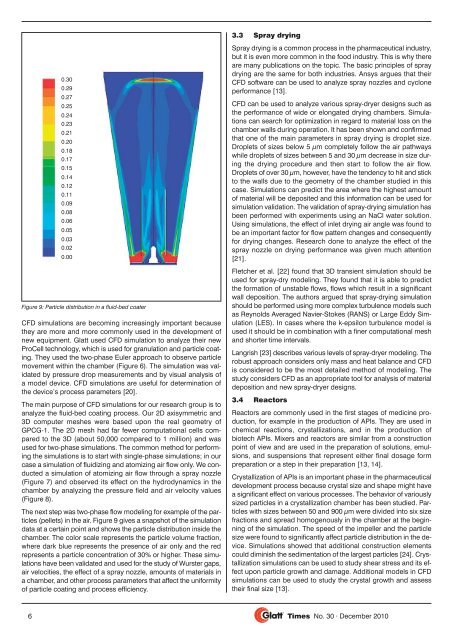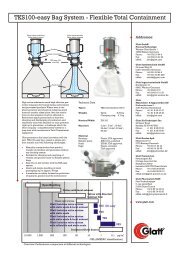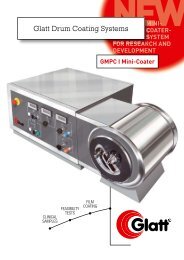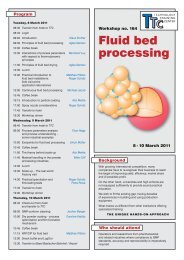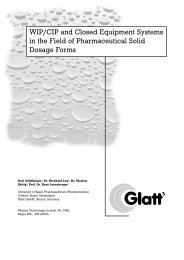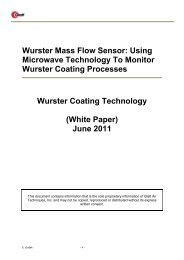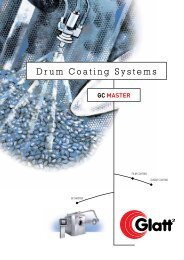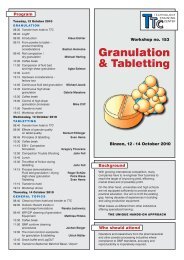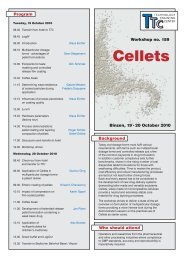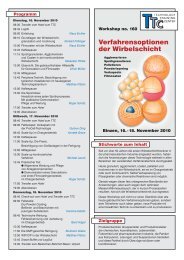No. 30 - Glatt
No. 30 - Glatt
No. 30 - Glatt
You also want an ePaper? Increase the reach of your titles
YUMPU automatically turns print PDFs into web optimized ePapers that Google loves.
CFD simulations are becoming increasingly important because<br />
they are more and more commonly used in the development of<br />
new equipment. <strong>Glatt</strong> used CFD simulation to analyze their new<br />
ProCell technology, which is used for granulation and particle coating.<br />
They used the two-phase Euler approach to observe particle<br />
movement within the chamber (Figure 6). The simulation was validated<br />
by pressure drop measurements and by visual analysis of<br />
a model device. CFD simulations are useful for determination of<br />
the device’s process parameters [20].<br />
The main purpose of CFD simulations for our research group is to<br />
analyze the fluid-bed coating process. Our 2D axisymmetric and<br />
3D computer meshes were based upon the real geometry of<br />
GPCG-1. The 2D mesh had far fewer computational cells compared<br />
to the 3D (about 50,000 compared to 1 million) and was<br />
used for two-phase simulations. The common method for performing<br />
the simulations is to start with single-phase simulations; in our<br />
case a simulation of fluidizing and atomizing air flow only. We conducted<br />
a simulation of atomizing air flow through a spray nozzle<br />
(Figure 7) and observed its effect on the hydrodynamics in the<br />
chamber by analyzing the pressure field and air velocity values<br />
(Figure 8).<br />
The next step was two-phase flow modeling for example of the particles<br />
(pellets) in the air. Figure 9 gives a snapshot of the simulation<br />
data at a certain point and shows the particle distribution inside the<br />
chamber. The color scale represents the particle volume fraction,<br />
where dark blue represents the presence of air only and the red<br />
represents a particle concentration of <strong>30</strong>% or higher. These simulations<br />
have been validated and used for the study of Wurster gaps,<br />
air velocities, the effect of a spray nozzle, amounts of materials in<br />
a chamber, and other process parameters that affect the uniformity<br />
of particle coating and process efficiency.<br />
6<br />
0.<strong>30</strong><br />
0.29<br />
0.27<br />
0.25<br />
0.24<br />
0.23<br />
0.21<br />
0.20<br />
0.18<br />
0.17<br />
0.15<br />
0.14<br />
0.12<br />
0.11<br />
0.09<br />
0.08<br />
0.06<br />
0.05<br />
0.03<br />
0.02<br />
0.00<br />
Figure 9: Particle distribution in a fluid-bed coater<br />
3.3 Spray drying<br />
Spray drying is a common process in the pharmaceutical industry,<br />
but it is even more common in the food industry. This is why there<br />
are many publications on the topic. The basic principles of spray<br />
drying are the same for both industries. Ansys argues that their<br />
CFD software can be used to analyze spray nozzles and cyclone<br />
performance [13].<br />
CFD can be used to analyze various spray-dryer designs such as<br />
the performance of wide or elongated drying chambers. Simulations<br />
can search for optimization in regard to material loss on the<br />
chamber walls during operation. It has been shown and confirmed<br />
that one of the main parameters in spray drying is droplet size.<br />
Droplets of sizes below 5 μm completely follow the air pathways<br />
while droplets of sizes between 5 and <strong>30</strong> μm decrease in size during<br />
the drying procedure and then start to follow the air flow.<br />
Droplets of over <strong>30</strong> μm, however, have the tendency to hit and stick<br />
to the walls due to the geometry of the chamber studied in this<br />
case. Simulations can predict the area where the highest amount<br />
of material will be deposited and this information can be used for<br />
simulation validation. The validation of spray-drying simulation has<br />
been performed with experiments using an NaCl water solution.<br />
Using simulations, the effect of inlet drying air angle was found to<br />
be an important factor for flow pattern changes and consequently<br />
for drying changes. Research done to analyze the effect of the<br />
spray nozzle on drying performance was given much attention<br />
[21].<br />
Fletcher et al. [22] found that 3D transient simulation should be<br />
used for spray-dry modeling. They found that it is able to predict<br />
the formation of unstable flows, flows which result in a significant<br />
wall deposition. The authors argued that spray-drying simulation<br />
should be performed using more complex turbulence models such<br />
as Reynolds Averaged Navier-Stokes (RANS) or Large Eddy Simulation<br />
(LES). In cases where the k-epsilon turbulence model is<br />
used it should be in combination with a finer computational mesh<br />
and shorter time intervals.<br />
Langrish [23] describes various levels of spray-dryer modeling. The<br />
robust approach considers only mass and heat balance and CFD<br />
is considered to be the most detailed method of modeling. The<br />
study considers CFD as an appropriate tool for analysis of material<br />
deposition and new spray-dryer designs.<br />
3.4 Reactors<br />
Reactors are commonly used in the first stages of medicine production,<br />
for example in the production of APIs. They are used in<br />
chemical reactions, crystallizations, and in the production of<br />
biotech APIs. Mixers and reactors are similar from a construction<br />
point of view and are used in the preparation of solutions, emulsions,<br />
and suspensions that represent either final dosage form<br />
preparation or a step in their preparation [13, 14].<br />
Crystallization of APIs is an important phase in the pharmaceutical<br />
development process because crystal size and shape might have<br />
a significant effect on various processes. The behavior of variously<br />
sized particles in a crystallization chamber has been studied. Particles<br />
with sizes between 50 and 900 μm were divided into six size<br />
fractions and spread homogenously in the chamber at the beginning<br />
of the simulation. The speed of the impeller and the particle<br />
size were found to significantly affect particle distribution in the device.<br />
Simulations showed that additional construction elements<br />
could diminish the sedimentation of the largest particles [24]. Crystallization<br />
simulations can be used to study shear stress and its effect<br />
upon particle growth and damage. Additional models in CFD<br />
simulations can be used to study the crystal growth and assess<br />
their final size [13].<br />
Times <strong>No</strong>. <strong>30</strong> · December 2010


